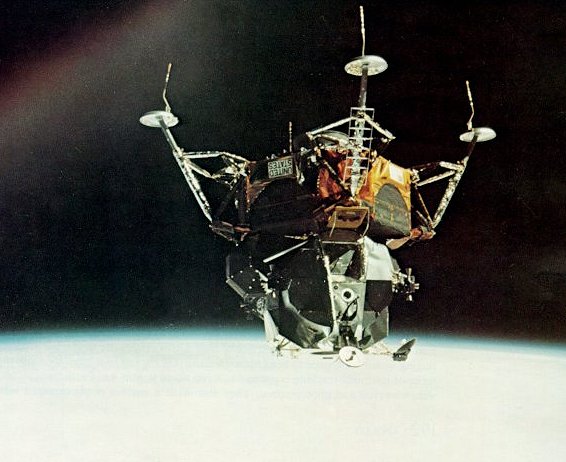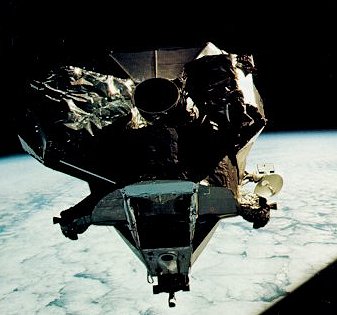Apollo Expeditions to the Moon
DESCENT ENGINE FIRED
McDivitt and Schweickart entered the lunar module on the
third day in orbit and powered it up to check out its systems and
to fire the descent engine while in the docked condition. The
engine burn lasted more than six minutes, during which time the
crew controlled the engine manually, and also demonstrated
digital-autopilot attitude control. After returning to the
command module, the full crew made the fifth of the docked
maneuvers, using the service propulsion system.
Early on the fourth day, Schweickart and Scott began their
extravehicular activity, that spectacular and exhilarating solo
performance outside the spacecraft. Unfortunately, Schweickart
had been affected by a form of motion sickness during the
previous days, a difficulty that later led to a regime of zero-G
flights for all crews during the last days before launch. But
this time it affected the planned time line for the EVA, and it
was decided to reduce the activities outside the spacecraft.
| | |
First manned flight of an unearthly
spacecraft (it couldn't
survive atmospheric reentry) took
place over the cloud-shrouded
Sahara, above. Note the contact
probes projecting from the footpads,
and the ladder leading
from the "front porch" with their
"golden slippers" boot retainers.
Below, after its landing stage
has been jettisoned, the lunar
module returns from the successful
completion of the first rendezvous.
Before docking begins, it
rotates in front of CM windows to
be inspected for possible damage.
The bell of the vital ascent
engine protrudes from a nest of
foil thermal insulation.
|
Schweickart went into the lunar module, which was
depressurized, and left it by way of the exit hatch that would
later be used by the astronauts who landed on the Moon. He stayed
around the platform - the "front porch" as the astronauts called
it - by that hatch for about three-quarters of an hour, checking
the handholds and the lights that had been trained on specific
portions of the spacecraft. Scott, meantime, had opened the
command module hatch and clambered partially outside, still
hooked to the spacecraft through a life-support umbilical system.
Schweickart was using a portable life-support system in his
EVA, checking it for the first time outside. Both men detailed
their experiences, took some photographs, and retrieved some
thermal samples, testing the maneuverability of the space suits
and the accessibility of the sample locations on the spacecraft.
We had planned to have Schweickart move externally from the LM to
the command module, to verify a way of getting from one
spacecraft to the other if the tunnel were not available. This
step was not completed beyond evaluating the specific handholds
that would have been necessary to such a transfer.
|


